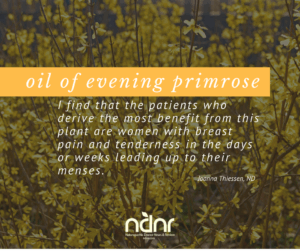Vis Medicatrix Naturae
Joanna Thiessen, ND
Oenothera biennis, or evening primrose, is a plant native to North America which has characteristic yellow flowers that are fully or partially closed during the day and open in the evening. The flowers bloom for 1-2 days and are bright yellow-gold, 2-5 cm in diameter, with 4 petals.1 The plant flowers from June to October. The stem is erect, branching at the top, and covered with hairs. It is a hardy plant, surviving in a variety of different types of soils, and found in dry, open fields, at the side of the road, and in open woods. Other names for this plant include: field primrose, German rampion, night willowherb, wild four o’clock, King’s cure-all, and fever plant.2

Evening Primrose
Use by Traditional Cultures
Oenothera biennis, while used frequently in women’s health today, has a history of traditional use that was not specific to women. Several North American tribes, including Ojibwas, Cherokee, Iroquois, and Potawatomi are known to have used evening primrose for both its nutritive and medicinal properties.3 When boiled, the roots were eaten like potatoes, and the cooked young leaves were eaten as well. The shoots were eaten raw. A tea made from evening primrose was used as a digestive stimulant to treat obesity. Topically, the roots were made into a hot poultice for the treatment of boils and hemorrhoids. A poultice using the entire plant was a treatment for bruises. Evening primrose was also used to treat the pain from menstrual or bowel cramping.3
Use by Europeans
During the 18th century, Europeans began using Oenothera biennis medicinally. German-born physician Johann David Schopf describes use of this plant as a fresh poultice for wounds in his 1787 book Materia Medica Americana. Dr R. Eglesfeld Griffith wrote in his 1847 classic Medicinal Botany about the benefits of evening primrose topically for eczematous eruptions.4 The use of Oenothera biennis for atopic dermatitis continues. In fact, eczema is one of the most heavily researched topics relating to this plant.
Active Constituents
The seed of the evening primrose plant contains an oil that is 7-14% gamma-linolenic acid (GLA) and 10% linoleic acid.5 Both are omega-6 polyunsaturated fatty acids that are essential, meaning they cannot be synthesized by the body. GLA is an unusual constituent and is found in very few plants. Other plants that contain GLA include borage (Borago officinalis), black currant (Ribes nigrum) and hemp (Cannabis sativa). Evening primrose oil (EPO) also contains vitamin E.
GLA is converted in the body to dihomo-gamma-linolenic acid (DGLA), which is the precursor to the anti-inflammatory series 1 prostaglandins. If GLA is not supplied adequately through diet or supplementation, it is typically derived from linoleic acid via the rate-limiting enzyme, delta-6 desaturase. This conversion requires nutrients, such as magnesium, zinc, vitamin E, vitamin B3, and vitamin B6.6 If GLA is supplied directly to the body through supplementation with EPO, the rate-limiting enzyme step is bypassed and the anti-inflammatory metabolites are produced more readily.
Evening primrose seeds also contain the amino acids phenylalanine and tyrosine, which are dopamine precursors. Dopamine plays a significant role in the regulation of the hormone prolactin. This may account for the use of this plant for conditions such as polycystic ovarian syndrome, which involves hyperprolactinemia.
Modern-Day Use of EPO
 A PubMed search of evening primrose oil brings up over 600 studies mentioning this plant and its uses in medicine. The most heavily researched areas of use include atopic dermatitis, rheumatoid arthritis, multiple sclerosis, mastalgia, and hot flashes. Apart from atopic dermatitis, most of the systematic reviews on EPO conclude that there is not significantly strong evidence of efficacy for the indicated ailments. Despite the lack of scientific studies demonstrating efficacy, both patients and practitioners have found benefit from using EPO as a remedy for a variety of ailments.
A PubMed search of evening primrose oil brings up over 600 studies mentioning this plant and its uses in medicine. The most heavily researched areas of use include atopic dermatitis, rheumatoid arthritis, multiple sclerosis, mastalgia, and hot flashes. Apart from atopic dermatitis, most of the systematic reviews on EPO conclude that there is not significantly strong evidence of efficacy for the indicated ailments. Despite the lack of scientific studies demonstrating efficacy, both patients and practitioners have found benefit from using EPO as a remedy for a variety of ailments.
How I Use EPO in Practice
With a practice focused on women’s health, I use the oil of evening primrose frequently in practice. I find that the patients who derive the most benefit from this plant are women with breast pain and tenderness in the days or weeks leading up to their menses. The use of EPO as a treatment for mastalgia has been explored in scientific studies, and a 2014 systematic review of the research on mastalgia concluded that evening primrose oil was ineffective.7 However, I find clinically that many women experience significant symptomatic relief from this herb. The dose I suggest for mastalgia is 1000 mg BID of EPO (containing 9-10% GLA). Because of the anti-inflammatory action of GLA and its ability to inhibit prolactin, I also find evening primrose to be a helpful adjunctive treatment for endometriosis, premenstrual syndrome, and polycystic ovarian syndrome.
When I first started out in practice, it was a common recommendation by local midwives to have pregnant patients start EPO both orally and vaginally as they approached full term. Although I followed this recommendation for several years, I currently do not recommend it due to conflicting research about its effectiveness and safety for labor preparation and initiation. In particular, a small study involving 54 women demonstrated that oral evening primrose supplementation after 37 weeks may be correlated with longer labors and a greater risk of complications, including vacuum extraction and prolonged rupture of membranes.8
Topically, I recommend EPO for infants with atopic dermatitis. One capsule (1000 mg) massaged onto the abdomen twice daily is my common protocol to support production of the beneficial series 1 prostaglandins that reduce inflammation.
Summary
Oenothera biennis is a plant commonly found growing in many parts of North America and commonly sold as a supplement in the form of evening primrose oil. Traditional cultures used Oenothera biennis as both a food and a treatment for various ailments including skin wounds and bruises. The oil of evening primrose contains GLA, which promotes the synthesis of anti-inflammatory prostaglandins; this makes it a potential treatment for conditions involving inflammation. EPO is often used in women’s health, and in my practice I find it to be an excellent treatment for premenstrual syndrome involving mastalgia. At this time, EPO is not considered by the medical literature to be proven safe for use in pregnancy, and its role as an agent to aid in labor induction is unclear and therefore not recommended.
References:
- Wildflower Center; the University of Texas at Austin. Native Plants Database: Oenothera biennis. Available at: http://www.wildflower.org/plants/result.php?id_plant=OEBI. Accessed July 19, 2016.
- Royal Horticultural Society. Oenothera biennis. Available at: https://www.rhs.org.uk/plants/details?plantid=1346. Accessed July 19, 2016.
- United States Department of Agriculture; Natural Resources Conservation Service. Oenothera biennis L. Available at: http://plants.usda.gov/core/profile?symbol=OEBI. Accessed July 19, 2016.
- Foster S. Benefits of Evening Primrose. March/April 1997. Mother Earth Living Web site. http://www.motherearthliving.com/plant-profile/evening-primrose.aspx?PageId=2#ArticleContent. Accessed July 17, 2016.
- Hoffman D. Medical Herbalism: The Science and Practice of Herbal Medicine. Rochester, VT: Healing Arts Press; 2003.
- Gamma linolenic acid (GLA). Orthomolecular.org Web site. http://orthomolecular.org/nutrients/gla.html. Accessed July 17, 2016.
- Kataria K, Dhar A, Srivastava A, et al. A systematic review of current understanding and management of mastalgia. Indian J Surg. 2014;76(3):217-222.
- Dove D, Johnson P. Oral evening primrose oil: its effect on length of pregnancy and selected intrapartum outcomes in low-risk nulliparous women. J Nurse Midwifery. 1999; 44(3):320-324.
 Joanna Thiessen, ND, was born in Calgary and grew up in Toronto. From a young age, she was treated with herbal medicines and homeopathic remedies by her mom, who had a keen interest in alternative therapies. Dr Joanna graduated from the Canadian College of Naturopathic Medicine in 2006 and started her family-focused naturopathic practice in Waterloo, Ontario, in 2007. Along the way, her family has grown to include 3 healthy children. Dr Joanna is passionate about both her work as a naturopathic doctor and her important job of being a mom.
Joanna Thiessen, ND, was born in Calgary and grew up in Toronto. From a young age, she was treated with herbal medicines and homeopathic remedies by her mom, who had a keen interest in alternative therapies. Dr Joanna graduated from the Canadian College of Naturopathic Medicine in 2006 and started her family-focused naturopathic practice in Waterloo, Ontario, in 2007. Along the way, her family has grown to include 3 healthy children. Dr Joanna is passionate about both her work as a naturopathic doctor and her important job of being a mom.



